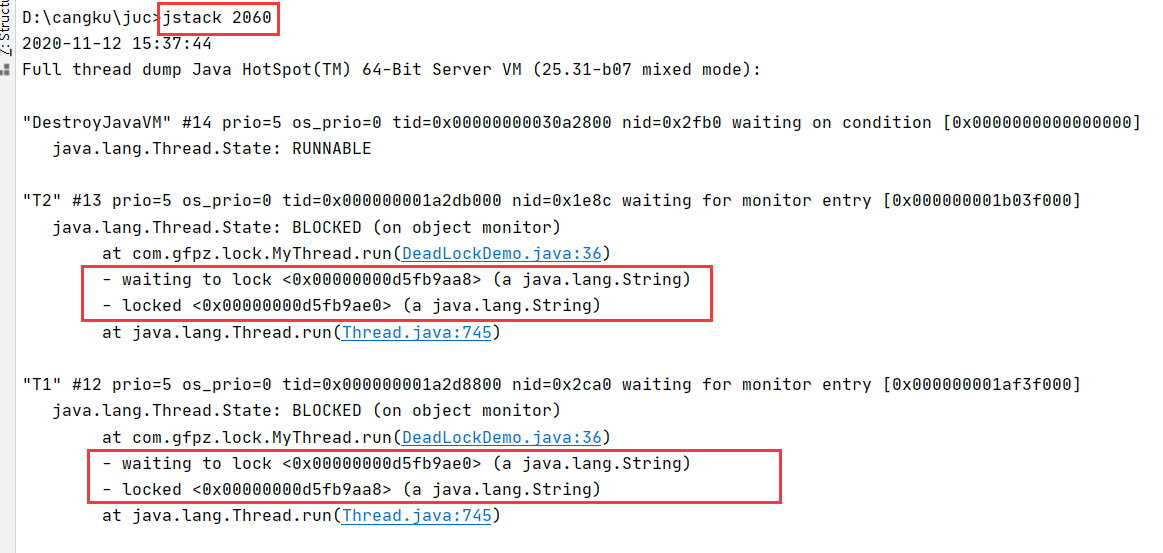JUC并发编程丶
工程准备
新建项目
- 新建maven项目juc
- 设置好maven配置
- Project Structure面板Project和Modules配置Java版本
- Settings面板中搜javac配置好编译器版本
在线JDK
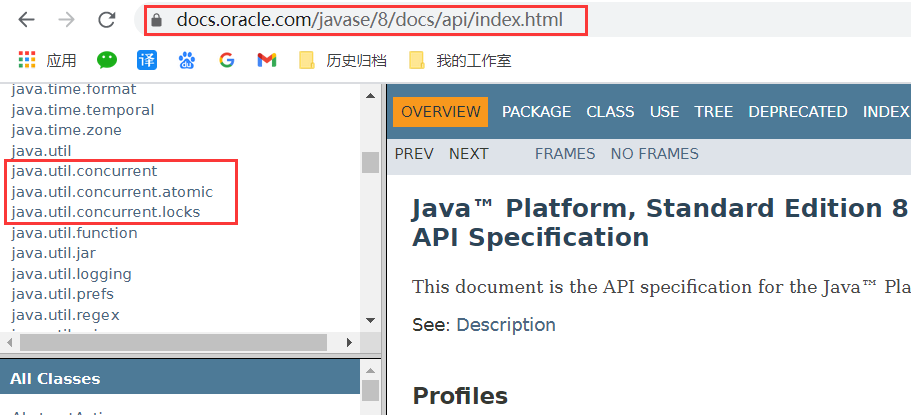
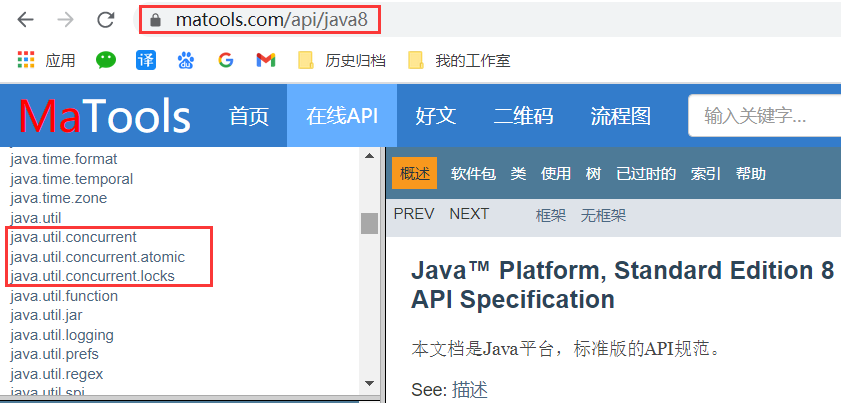
Java线程
Java默认有两个线程:main线程和GC线程
Java本身不能开启一个线程(不能操作硬件),是通过调用native本地C++方法对硬件进行操作
并发和并行
并发(多线程操作同一个资源类)
- CPU一核,同时服务多个线程,快速交替
- 要提高性能,核心是把握:充分利用CPU资源
并行(CPU多核(多个逻辑处理器)的前提下)
- 多核,多个线程可以同时执行
- 要提高性能可以使用线程池
package com.gfpz.demo01;
public class Test1 {
public static void main(String[] args) {
// new Thread().start();
//获取cpu核数
//CPU密集型,IO密集型
System.out.println(Runtime.getRuntime().availableProcessors());
}
}
线程的状态
Jdk源码中Thread.State是有6个状态(可能Java不要操作的状态没有列出来)
WAITING 和 TIMED_WAITING:前者会一直等,后者是限制了时间的等待
wait()和sleep()
- wait()属于Object类;sleep()属于Thread类
- wait()会释放锁;sleep()睡觉了,抱着锁睡的,不会释放锁
- wait()必须在同步代码块中使用();sleep()可以在任意地方睡觉
- wait()、sleep()都需要捕获InterruptedException异常
同步方式:synchronized
package com.gfpz.demo01;
//基本的卖票例子
/**
* 公司中的开发,降低耦合性
* 线程就是一个单独的资源类,它没有任何附属操作
*/
public class SaleTicketDemo01 {
public static void main(String[] args) {
Ticket ticket = new Ticket();
new Thread(() -> {for (int i = 0; i < 60; i++) ticket.sale();}, "A").start();
new Thread(() -> {for (int i = 0; i < 60; i++) ticket.sale();}, "B").start();
new Thread(() -> {for (int i = 0; i < 60; i++) ticket.sale();}, "C").start();
}
}
//资源类 OOP
class Ticket {
private int number = 50;
//synchronized 本质是 队列/锁
public synchronized void sale() {
if (number > 0) {
System.out.println(Thread.currentThread().getName() + "卖出了第:" + (50 - number--) + "张票,剩余:" + number + "张票");
}
}
}
同步方式:Lock(JUC)
锁代码块,手动开启和关闭(按照JDK固定模板)

package com.gfpz.demo01;
import java.util.concurrent.locks.Lock;
import java.util.concurrent.locks.ReentrantLock;
public class SaleTicketDemo02 {
public static void main(String[] args) {
Ticket2 ticket2 = new Ticket2();
new Thread(() -> {for (int i = 0; i < 100; i++) ticket2.sale();}, "A").start();
new Thread(() -> {for (int i = 0; i < 100; i++) ticket2.sale();}, "B").start();
new Thread(() -> {for (int i = 0; i < 100; i++) ticket2.sale();}, "C").start();
}
}
class Ticket2 {
private int number = 60;
Lock l = new ReentrantLock();
public void sale() {
l.lock();
try { // 业务代码
if (number > 0) {
System.out.println(Thread.currentThread().getName() + "卖出了第:" + (60 - number--) + "张票,剩余:" + number + "张票");
}
} finally {
l.unlock();
}
}
}
synchronized 与 Lock 的区别:
- synchronized 是Java内置的关键字,Lock是一个Java类
- synchronized 无法判断获取锁的状态,Lock可以判断是否获取到了锁
- synchronized 会自动释放锁,Lock必须要手动释放,不释放会死锁
- synchronized 线程会阻塞着一直等待锁,Lock可以通过 tryLock() 非阻塞方式获取锁
- synchronized 可重入锁,不可以中断的,非公平;Lock 可重入锁,可以判断锁,非公平(可设置)
- synchronized 适合锁少量的代码同步问题,Lock适合大量的同步代码,Lock更加灵活
- synchronized 使用形式是 锁方法或对象(代码块形式),Lock是按固定形式new锁对象/释放锁对象
- Lock 更细粒度,更精准的通知唤醒
生产者消费者:synchronized
package com.gfpz.pc;
/**
* 线程之间操作同一个资源,通过等待和唤醒进行通信
*/
public class A {
public static void main(String[] args) {
Data data = new Data();
//生产
new Thread(()->{
for (int i = 0; i < 10; i++) {
try {
data.increment();
} catch (InterruptedException e) {
e.printStackTrace();
}
}
},"A").start();
//消费
new Thread(()->{
for (int i = 0; i < 10; i++) {
try {
data.decrement();
} catch (InterruptedException e) {
e.printStackTrace();
}
}
},"B").start();
}
}
//生产者消费者:等待 业务 通知 面试手写(单例模式、排序算法、生产者消费者、死锁)
class Data {
private int number;
public synchronized void increment() throws InterruptedException {
if (number != 0) {//等于0才进行+1,不等于0等着
//等待
this.wait();
}
number++;
System.out.println(Thread.currentThread().getName() + "=>" + number);
//通知其他线程,我+1完了
this.notifyAll();
}
public synchronized void decrement() throws InterruptedException {
if (number == 0) {//不等于0才进行-1,等于0等着
//等待
this.wait();
}
number--;
System.out.println(Thread.currentThread().getName() + "=>" + number);
//通知其他线程,我-1完了
this.notifyAll();
}
}
上面只开启A,B线程时没有问题,但是多开一组生产者消费者C,D的时候,就会有问题,原因是wait存在虚假唤醒的问题,需要写在while循环中。
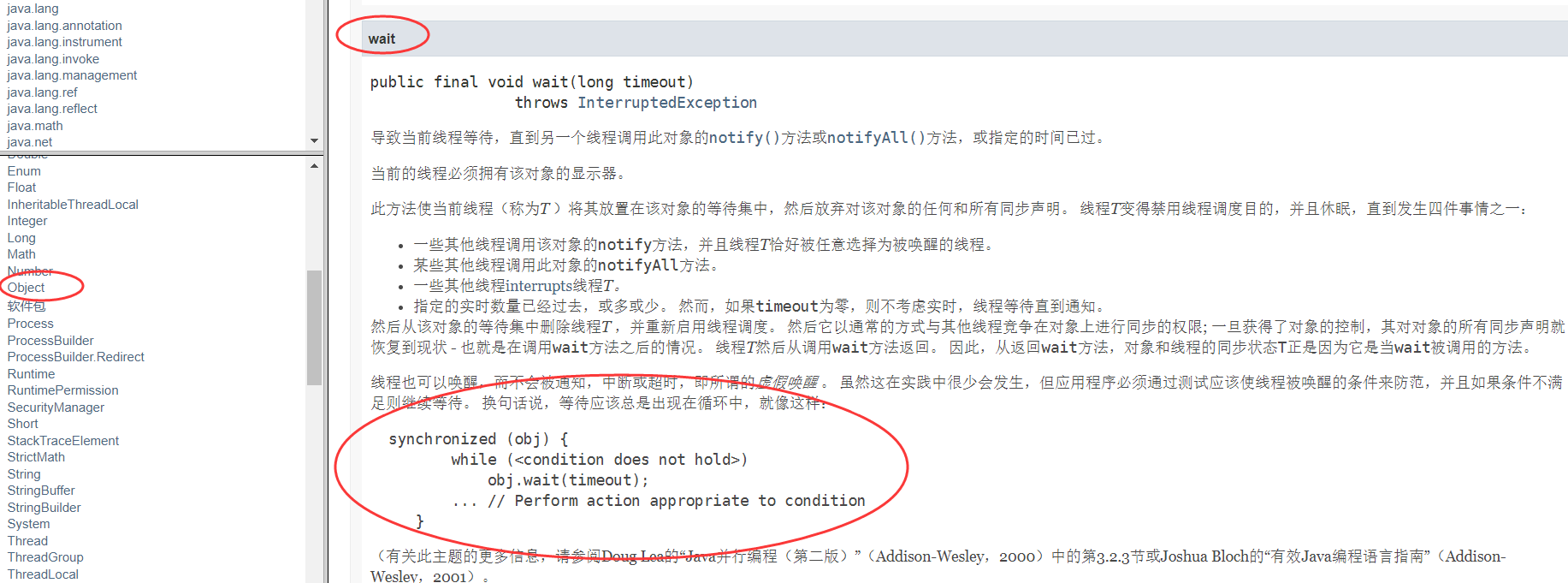
将if改成while即可
package com.gfpz.pc;
/**
* 线程之间操作同一个资源,通过等待和唤醒进行通信
*/
public class A {
public static void main(String[] args) {
Data data = new Data();
//生产
new Thread(()->{
for (int i = 0; i < 10; i++) {
try {
data.increment();
} catch (InterruptedException e) {
e.printStackTrace();
}
}
},"A").start();
//消费
new Thread(()->{
for (int i = 0; i < 10; i++) {
try {
data.decrement();
} catch (InterruptedException e) {
e.printStackTrace();
}
}
},"B").start();
//生产
new Thread(()->{
for (int i = 0; i < 10; i++) {
try {
data.increment();
} catch (InterruptedException e) {
e.printStackTrace();
}
}
},"C").start();
//消费
new Thread(()->{
for (int i = 0; i < 10; i++) {
try {
data.decrement();
} catch (InterruptedException e) {
e.printStackTrace();
}
}
},"D").start();
}
}
//生产者消费者:等待 业务 通知 面试手写(单例模式、排序算法、生产者消费者、死锁)
class Data {
private int number;
public synchronized void increment() throws InterruptedException {
while (number != 0) {//等于0才进行+1,不等于0等着
//等待
this.wait();
}
number++;
System.out.println(Thread.currentThread().getName() + "=>" + number);
//通知其他线程,我+1完了
this.notifyAll();
}
public synchronized void decrement() throws InterruptedException {
while (number == 0) {//不等于0才进行-1,等于0等着
//等待
this.wait();
}
number--;
System.out.println(Thread.currentThread().getName() + "=>" + number);
//通知其他线程,我-1完了
this.notifyAll();
}
}
生产者消费者:Lock(JUC)
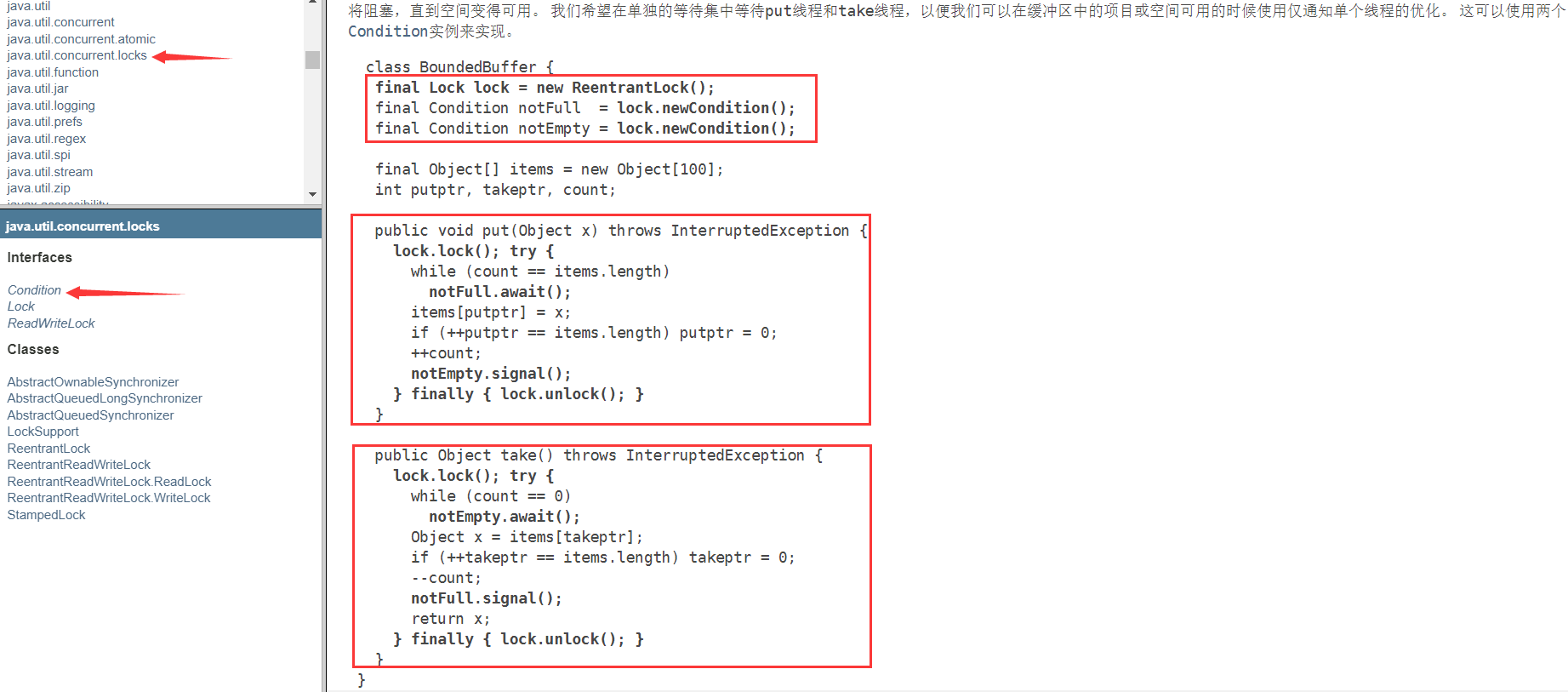
synchronized、wait、notifyAll都进行相应简单替换
package com.gfpz.pc;
import java.util.concurrent.locks.Condition;
import java.util.concurrent.locks.Lock;
import java.util.concurrent.locks.ReentrantLock;
/**
* 线程之间操作同一个资源,通过等待和唤醒机制进行通信
*/
public class B {
public static void main(String[] args) {
Data2 data = new Data2();
//生产
new Thread(()->{
for (int i = 0; i < 10; i++) {
try {
data.increment();
} catch (InterruptedException e) {
e.printStackTrace();
}
}
},"A").start();
//消费
new Thread(()->{
for (int i = 0; i < 10; i++) {
try {
data.decrement();
} catch (InterruptedException e) {
e.printStackTrace();
}
}
},"B").start();
//生产
new Thread(()->{
for (int i = 0; i < 10; i++) {
try {
data.increment();
} catch (InterruptedException e) {
e.printStackTrace();
}
}
},"C").start();
//消费
new Thread(()->{
for (int i = 0; i < 10; i++) {
try {
data.decrement();
} catch (InterruptedException e) {
e.printStackTrace();
}
}
},"D").start();
}
}
//生产者消费者:等待 业务 通知 面试手写(单例模式、排序算法、生产者消费者、死锁)
class Data2 {
private int number;
final Lock lock = new ReentrantLock();
final Condition condition = lock.newCondition();
public void increment() throws InterruptedException {
lock.lock();
try {
while (number != 0) {//等于0才进行+1,不等于0等着
//等待
condition.await();
}
number++;
System.out.println(Thread.currentThread().getName() + "=>" + number);
//通知其他线程,我+1完了
condition.signalAll();
} finally {lock.unlock();}
}
public void decrement() throws InterruptedException {
lock.lock();
try {
while (number == 0) {//不等于0才进行-1,等于0等着
//等待
condition.await();
}
number--;
System.out.println(Thread.currentThread().getName() + "=>" + number);
//通知其他线程,我-1完了
condition.signalAll();
} finally {lock.unlock();}
}
}
但是,这样做还不够,没有充分利用Lock的功能;精准的通知/唤醒一个线程才是它的最佳实践
package com.gfpz.pc;
import java.util.concurrent.locks.Condition;
import java.util.concurrent.locks.Lock;
import java.util.concurrent.locks.ReentrantLock;
/**
* A执行完调用B,B执行完调用C,C执行完调用A
*/
public class C {
public static void main(String[] args) {
Data3 data = new Data3();
new Thread(()->{
for (int i = 0; i < 10; i++) {
data.printA();
}
},"A").start();
new Thread(()->{
for (int i = 0; i < 10; i++) {
data.printB();
}
},"B").start();
new Thread(()->{
for (int i = 0; i < 10; i++) {
data.printC();
}
},"C").start();
}
}
class Data3 {
private int number = 1;//1A 2B 3C
private Lock lock = new ReentrantLock();
private Condition condition1 = lock.newCondition();
private Condition condition2 = lock.newCondition();
private Condition condition3 = lock.newCondition();
public void printA() {
lock.lock();try{
while (number != 1) {
condition1.await();
}
System.out.println(Thread.currentThread().getName() + "=>AAA");
number = 2;
//唤醒B
condition2.signal();
} catch (InterruptedException e) {
e.printStackTrace();
} finally{lock.unlock();}
}
public void printB() {
lock.lock();try{
while (number != 2) {
condition2.await();
}
System.out.println(Thread.currentThread().getName() + "=>BBB");
number = 3;
//唤醒C
condition3.signal();
} catch (InterruptedException e) {
e.printStackTrace();
} finally{lock.unlock();}
}
public void printC() {
lock.lock();try{
while (number != 3) {
condition3.await();
}
System.out.println(Thread.currentThread().getName() + "=>CCC");
number = 1;
//唤醒A
condition1.signal();
} catch (InterruptedException e) {
e.printStackTrace();
} finally{lock.unlock();}
}
}
锁应用的问题
同步方法,锁调用方法的对象,挟对象以执行方法,执行完才能释放
package com.gfpz.lock8;
import java.util.concurrent.TimeUnit;
/**
* 先打印啥?发短信还是打电话
*/
public class Test1 {
public static void main(String[] args) {
Phone phone = new Phone();
new Thread(()->{phone.sendSms();},"A").start();
try {
TimeUnit.SECONDS.sleep(1);
} catch (InterruptedException e) {
e.printStackTrace();
}
new Thread(()->{phone.call();},"B").start();
}
}
class Phone{
//synchronized 锁的是方法的调用者,就是上面new的phone对象,先调用的哪个就执行哪个
public synchronized void sendSms() {
try {
TimeUnit.SECONDS.sleep(4);
} catch (InterruptedException e) {
e.printStackTrace();
}
System.out.println("发短信");
}
public synchronized void call() {
System.out.println("打电话");
}
}
非同步方法不需要等待对象释放锁
package com.gfpz.lock8;
import java.util.concurrent.TimeUnit;
/**
* 先打印啥?发短信还是hello
*/
public class Test2 {
public static void main(String[] args) {
Phone2 phone = new Phone2();
new Thread(()->{phone.sendSms();},"A").start();
try {
TimeUnit.SECONDS.sleep(1);
} catch (InterruptedException e) {
e.printStackTrace();
}
new Thread(()->{phone.hello();},"B").start();//不受锁的影响
}
}
class Phone2{
//synchronized 锁的是方法的调用者,就是上面new的phone对象,先调用的哪个就执行哪个
public synchronized void sendSms() {
try {
TimeUnit.SECONDS.sleep(4);
} catch (InterruptedException e) {
e.printStackTrace();
}
System.out.println("发短信");
}
public synchronized void call() {
System.out.println("打电话");
}
public void hello() {
System.out.println("hello");
}
}
不同的对象不考虑等待锁释放
package com.gfpz.lock8;
import java.util.concurrent.TimeUnit;
/**
* 先打印啥?显然是打电话
*/
public class Test3 {
public static void main(String[] args) {
Phone3 phone1 = new Phone3();
Phone3 phone2 = new Phone3();
new Thread(()->{phone1.sendSms();},"A").start();
try {
TimeUnit.SECONDS.sleep(1);
} catch (InterruptedException e) {
e.printStackTrace();
}
new Thread(()->{phone2.call();},"B").start();
}
}
class Phone3{
public synchronized void sendSms() {
try {
TimeUnit.SECONDS.sleep(4);
} catch (InterruptedException e) {
e.printStackTrace();
}
System.out.println("发短信");
}
public synchronized void call() {
System.out.println("打电话");
}
public void hello() {
System.out.println("hello");
}
}
加了 static 的 synchronized 锁的是类的 Class 对象
package com.gfpz.lock8;
import java.util.concurrent.TimeUnit;
/**
* 这个需要记住!关注 synchronized 是不是加了static,所以出现 synchronized 就要关注它锁的是什么
*/
public class Test4 {
public static void main(String[] args) {
Phone4 phone = new Phone4();
Phone4 phone2 = new Phone4();
new Thread(()->{phone.sendSms();},"A").start();
try {
TimeUnit.SECONDS.sleep(1);
} catch (InterruptedException e) {
e.printStackTrace();
}
new Thread(()->{phone2.call();},"B").start();
}
}
class Phone4 {
//锁的是 Phone4的Class对象
public static synchronized void sendSms() {
try {
TimeUnit.SECONDS.sleep(4);
} catch (InterruptedException e) {
e.printStackTrace();
}
System.out.println("发短信");
}
public static synchronized void call() {
System.out.println("打电话");
}
}
类的对象 和 类的Class对象
package com.gfpz.lock8;
import java.util.concurrent.TimeUnit;
/**
* 打电话 (关注第二个方法调用处是否需要等待第一个方法释放锁)
*/
public class Test5 {
public static void main(String[] args) {
Phone5 phone = new Phone5();
Phone5 phone2 = new Phone5();
new Thread(()->{phone.sendSms();},"A").start();
try {
TimeUnit.SECONDS.sleep(1);
} catch (InterruptedException e) {
e.printStackTrace();
}
new Thread(()->{phone.call();},"B").start();
}
}
class Phone5 {
//静态
public static synchronized void sendSms() {
try {
TimeUnit.SECONDS.sleep(4);
} catch (InterruptedException e) {
e.printStackTrace();
}
System.out.println("发短信");
}
//普通
public synchronized void call() {
System.out.println("打电话");
}
}
集合安全问题
并发修改异常java.util.ConcurrentModificationException
List
package com.gfpz.unsafe;
import java.util.*;
import java.util.concurrent.CopyOnWriteArrayList;
public class ListTest {
public static void main(String[] args) {
// List<String> list = Arrays.asList("1", "2", "3");
// list.forEach(System.out::println);
/**
* 并发下 ArrayList 是不安全的
* 方案1:安全list:List<String> list = new Vector<>();
* 方案2:用工具类让它变得安全:List<String> list = Collections.synchronizedList(new ArrayList<>());
* 方案3:JUC写入时复制:List<String> list = new CopyOnWriteArrayList<>();
*/
List<String> list = new CopyOnWriteArrayList<>();
for (int i = 1; i <= 10; i++) {
new Thread(() -> {
list.add(UUID.randomUUID().toString().substring(0, 5));
System.out.println(list);
}, String.valueOf(i)).start();
}
}
}
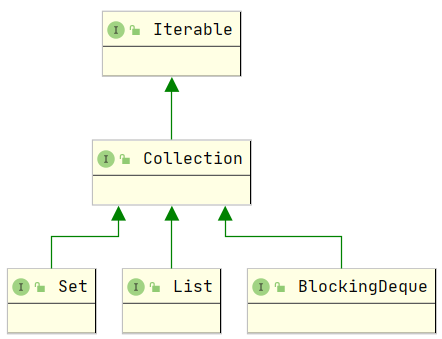
Set
package com.gfpz.unsafe;
import java.util.Collections;
import java.util.HashSet;
import java.util.Set;
import java.util.UUID;
import java.util.concurrent.CopyOnWriteArraySet;
/**
* 同理
* java.util.ConcurrentModificationException
*/
public class SetTest {
public static void main(String[] args) {
// Set<String> set = new HashSet<>();
// Set<String> set = Collections.synchronizedSet(new hashset<>());
Set<String> set = new CopyOnWriteArraySet<>();
for (int i = 1; i <= 30; i++) {
new Thread(() -> {
set.add(UUID.randomUUID().toString().substring(0, 5));
System.out.println(set);
}, String.valueOf(i)).start();
}
}
}
HashSet的底层就是HashMap
public HashSet() { map = new HashMap<>(); }public boolean add(E e) { return map.put(e, PRESENT)==null; }
Map
package com.gfpz.unsafe;
import java.util.*;
import java.util.concurrent.ConcurrentHashMap;
//ConcurrentModificationException
public class MapTest {
public static void main(String[] args) {
//Map 是这样用的吗?不是,工作中不用 HashMap
//Map 默认等价于什么 new HashMap<>(16,0.75);//加载因子、初始容量
// Map<String, String> map = new HashMap<>();
// Map<String, String> map = Collections.synchronizedMap(new HashMap<>());
Map<String, String> map = new ConcurrentHashMap<>();
for (int i = 1; i <= 30; i++) {
new Thread(() -> {
map.put(Thread.currentThread().getName(), UUID.randomUUID().toString().substring(0, 5));
System.out.println(map);
}, String.valueOf(i)).start();
}
}
}
ConcurrentHashMap/HashMap 的原理官方文档学习
Callable实现多线程
余生多线程就用者玩意儿吧丶
- java.util.concurrent包下的接口
- 可以有返回值
- 可以抛出异常
- 方法是call()
package com.gfpz.callable;
import java.util.concurrent.Callable;
import java.util.concurrent.ExecutionException;
import java.util.concurrent.FutureTask;
public class CallableTest {
public static void main(String[] args) throws ExecutionException, InterruptedException {
//FutureTask 实现了runnable接口,又可以通过callable进行构造
FutureTask futureTask = new FutureTask(new MyThread());
new Thread(futureTask,"A").start();
new Thread(futureTask,"B").start();//只会打印1个call,结果会被缓存
Integer ret = (Integer) futureTask.get();//这个方法可能产生阻塞,要放到最后,或者异步通信
System.out.println(ret);
}
}
//泛型对应call方法的返回值
class MyThread implements Callable<Integer> {
@Override
public Integer call() throws Exception {
System.out.println("call执行了");
return 1024;
}
}
常用的辅助类
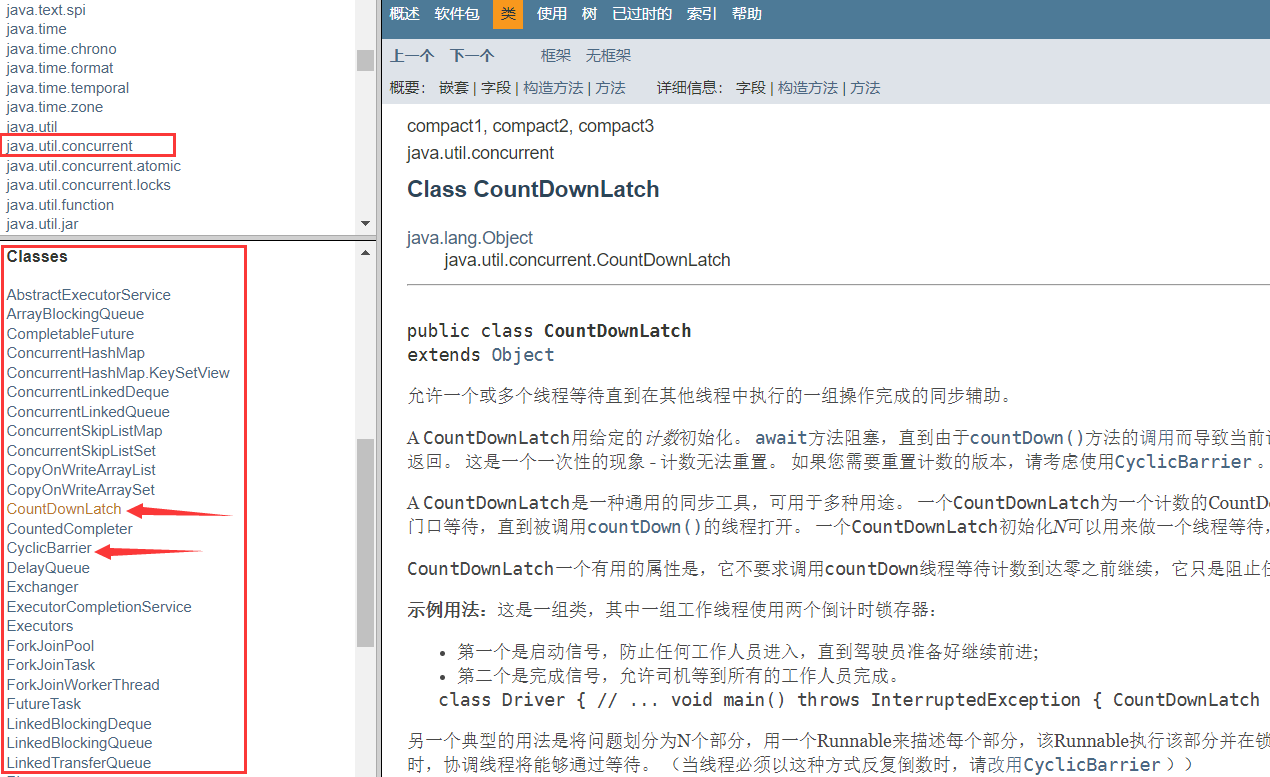
1、CountDownLatch 减法计数器
最佳实践:所有人出门了才关教室门
package com.gfpz.add;
import java.util.concurrent.CountDownLatch;
//计数器
public class CountDownLatchDemo {
public static void main(String[] args) throws InterruptedException {
//总数是6
CountDownLatch countDownLatch = new CountDownLatch(6);
for (int i = 1; i <= 6; i++) {
new Thread(()->{
System.out.println(Thread.currentThread().getName()+"Go out");
countDownLatch.countDown();//数量-1
},String.valueOf(i)).start();
}
countDownLatch.await();//阻塞,等待计数器归零,然后再向下执行
System.out.println("Close door");
}
}
2、CycleBarrier 加法计数器
最佳实践:集齐7颗龙珠召唤神龙
package com.gfpz.add;
import java.util.concurrent.BrokenBarrierException;
import java.util.concurrent.CyclicBarrier;
public class CyclicBarrierDemo {
public static void main(String[] args) {
/**
* 集齐7颗龙珠召唤神龙
*/
CyclicBarrier cyclicBarrier = new CyclicBarrier(7, () -> {
System.out.println("召唤神龙!");
});
for (int i = 1; i <= 7; i++) {
final int temp = i;//记住这个操作,在lambda中得到i的值
new Thread(()->{
System.out.println(Thread.currentThread().getName()+"收集第:"+temp+"颗龙珠");
try {
cyclicBarrier.await();
} catch (InterruptedException e) {
e.printStackTrace();
} catch (BrokenBarrierException e) {
e.printStackTrace();
}
}).start();
}
}
}
3、Semaphore 信号量
最佳实践:多个共享资源互斥的使用;并发限流,控制最大的线程数
package com.gfpz.add;
import java.util.concurrent.Semaphore;
import java.util.concurrent.TimeUnit;
public class SemaphoreDemo {
public static void main(String[] args) {
//线程数量:停车位
Semaphore semaphore = new Semaphore(3);
for (int i = 1; i <= 6; i++) {
new Thread(()->{
try {
semaphore.acquire();//得到车位
System.out.println(Thread.currentThread().getName() + "抢到车位");
TimeUnit.SECONDS.sleep(2);
System.out.println(Thread.currentThread().getName() + "离开车位");
} catch (InterruptedException e) {
e.printStackTrace();//释放
}
semaphore.release();
},String.valueOf(i)).start();
}
}
}
读写锁ReadWriteLock
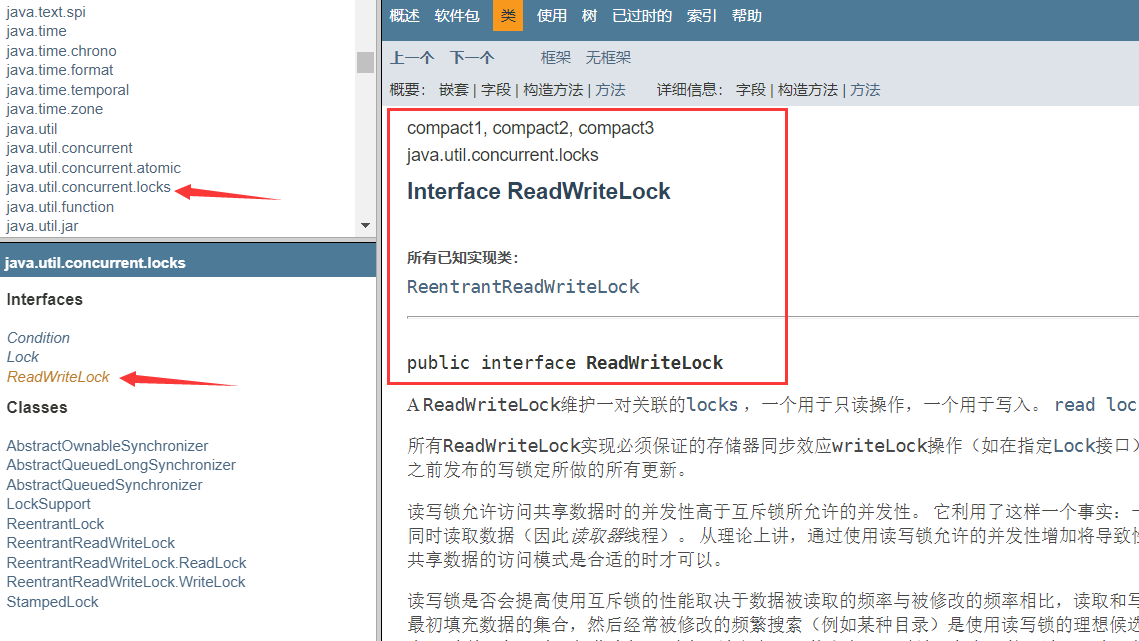
- 独占锁(写锁):一次只能被一个线程占有
- 共享锁(读锁):多个线程可以同时占有
package com.gfpz.rw;
import java.util.HashMap;
import java.util.Map;
import java.util.concurrent.locks.ReadWriteLock;
import java.util.concurrent.locks.ReentrantLock;
import java.util.concurrent.locks.ReentrantReadWriteLock;
public class ReadWriteLockDemo {
public static void main(String[] args) {
MyCacheLock myCache = new MyCacheLock();
//写入
for (int i = 1; i <= 5; i++) {
final int temp = i;
new Thread(() -> {
myCache.put(temp + "", temp + "");
}, String.valueOf(i)).start();
}
//读取
for (int i = 1; i <= 5; i++) {
final int temp = i;
new Thread(() -> {
myCache.get(temp + "");
}, String.valueOf(i)).start();
}
}
}
//加锁的
class MyCacheLock {
private volatile Map<String, Object> map = new HashMap<>();
//读写锁:更加细粒度的控制
private ReadWriteLock readWriteLock = new ReentrantReadWriteLock();
//写入的时候,只希望同时只有一个线程写
public void put(String key, Object value) {
readWriteLock.writeLock().lock();
try {
System.out.println(Thread.currentThread().getName() + "写入" + key);
map.put(key, value);
System.out.println(Thread.currentThread().getName() + "写入OK");
} catch (Exception e) {
e.printStackTrace();
} finally {
readWriteLock.writeLock().unlock();
}
}
//读 所有人都可以
public void get(String key) {
readWriteLock.readLock().lock();
try {
System.out.println(Thread.currentThread().getName() + "读取" + key);
Object o = map.get(key);
System.out.println(Thread.currentThread().getName() + "读取OK");
} catch (Exception e) {
e.printStackTrace();
} finally {
readWriteLock.readLock().unlock();
}
}
}
/**
* 自定义缓存,未加锁的
*/
class MyCache {
private volatile Map<String, Object> map = new HashMap<>();
public void put(String key, Object value) {
System.out.println(Thread.currentThread().getName() + "写入" + key);
map.put(key, value);
System.out.println(Thread.currentThread().getName() + "写入OK");
}
public void get(String key) {
System.out.println(Thread.currentThread().getName() + "读取" + key);
Object o = map.get(key);
System.out.println(Thread.currentThread().getName() + "读取OK");
}
}
阻塞队列BlockingQueue
BlockingQueue 同List、Set及Queue都是同级的,都继承了Collection接口,都有实现类诸如ArrayBlockingQueue、LinkedBlockingQueue
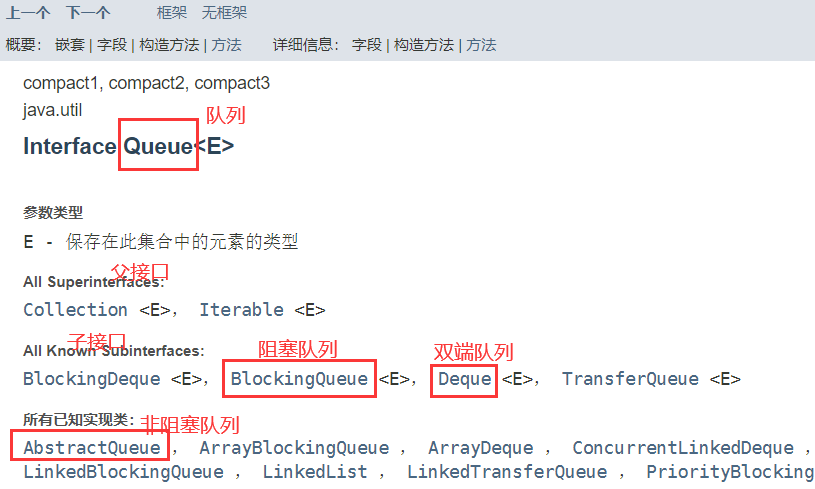
最佳实践:多线程并发处理、线程池,添加移除
主要了解四组API
| 动作 | 会抛出异常 | 不会抛出异常,有返回值 | 阻塞等待 | 超时等待 |
|---|---|---|---|---|
| 添加 | add | offer | put | offer("d", 2, TimeUnit.SECONDS) |
| 移除 | remove | poll | take | poll(2, TimeUnit.SECONDS) |
| 查看队首元素 | element | peek | - | - |
package com.gfpz.bq;
import java.util.concurrent.ArrayBlockingQueue;
import java.util.concurrent.TimeUnit;
public class Test {
public static void main(String[] args) throws InterruptedException {
// test1();
// test2();
// test3();
test4();
}
/**
* 抛出异常
*/
public static void test1() {
ArrayBlockingQueue blockingQueue = new ArrayBlockingQueue<>(3);//参数为队列的大小
System.out.println(blockingQueue.add("a"));
System.out.println(blockingQueue.add("b"));
System.out.println(blockingQueue.add("c"));
// System.out.println(blockingQueue.add("d"));//抛出异常 IllegalStateException: Queue full
System.out.println("队首元素:"+blockingQueue.element());//
System.out.println("-------------------------");
System.out.println(blockingQueue.remove());//FIFO 先进先出
System.out.println("队首元素:"+blockingQueue.element());//
System.out.println(blockingQueue.remove());
System.out.println(blockingQueue.remove());
// System.out.println(blockingQueue.remove());//NoSuchElementException
}
/**
* 不抛出异常,有返回值
*/
public static void test2() {
ArrayBlockingQueue blockingQueue = new ArrayBlockingQueue<>(3);//参数为队列的大小
System.out.println(blockingQueue.offer("a"));
System.out.println(blockingQueue.offer("b"));
System.out.println(blockingQueue.offer("c"));
System.out.println(blockingQueue.offer("d"));//返回 false 不抛出异常
System.out.println("队首元素:"+blockingQueue.peek());
System.out.println("-------------------------");
System.out.println(blockingQueue.poll());
System.out.println("队首元素:"+blockingQueue.peek());
System.out.println(blockingQueue.poll());
System.out.println(blockingQueue.poll());
System.out.println(blockingQueue.poll());//返回一个null,没有异常
}
/**
* 等待 阻塞(一直阻塞)
*/
public static void test3() throws InterruptedException {
ArrayBlockingQueue blockingQueue = new ArrayBlockingQueue<>(3);//参数为队列的大小
blockingQueue.put("a");
blockingQueue.put("b");
blockingQueue.put("c");
// blockingQueue.put("d");//队列里没有椅子了,会一直阻塞
System.out.println(blockingQueue.take());
System.out.println(blockingQueue.take());
System.out.println(blockingQueue.take());
// System.out.println(blockingQueue.take());//取不到,一直阻塞
}
/**
* 等待 阻塞(等待超时)
*/
public static void test4() throws InterruptedException {
ArrayBlockingQueue blockingQueue = new ArrayBlockingQueue<>(3);//参数为队列的大小
blockingQueue.offer("a");
blockingQueue.offer("b");
blockingQueue.offer("c");
//blockingQueue.offer("d", 2, TimeUnit.SECONDS);//超时时间 单位
System.out.println("-------------------------");
System.out.println(blockingQueue.poll());
System.out.println(blockingQueue.poll());
System.out.println(blockingQueue.poll());
System.out.println(blockingQueue.poll(2, TimeUnit.SECONDS));//2秒拿不到就不拿了 返回个null
}
}
同步队列SynchronousQueue
没有容量,进去一个元素,必须等待取出来之后,才能再往里边放一个元素
是上文阻塞队列BlockingQueue的实现类,同时也继承了非阻塞队列AbstractQueue
package com.gfpz.bq;
import java.util.concurrent.BlockingQueue;
import java.util.concurrent.SynchronousQueue;
import java.util.concurrent.TimeUnit;
/**
* 同步队列:让几个线程像几兄弟一样,保持一路
*/
public class SynchronousQueueDemo {
public static void main(String[] args) {
BlockingQueue<String> blockingQueue = new SynchronousQueue<>();//同步队列
new Thread(() -> {
try {
System.out.println(Thread.currentThread().getName() + " put 1 ");
blockingQueue.put("1");
System.out.println(Thread.currentThread().getName() + " put 2 ");
blockingQueue.put("2");
System.out.println(Thread.currentThread().getName() + " put 3 ");
blockingQueue.put("3");
} catch (InterruptedException e) {
e.printStackTrace();
}
}, "T1").start();
new Thread(() -> {
try {
TimeUnit.SECONDS.sleep(3);
System.out.println(Thread.currentThread().getName()+"-->"+blockingQueue.take());
TimeUnit.SECONDS.sleep(3);
System.out.println(Thread.currentThread().getName()+"-->"+blockingQueue.take());
TimeUnit.SECONDS.sleep(3);
System.out.println(Thread.currentThread().getName()+"-->"+blockingQueue.take());
} catch (InterruptedException e) {
e.printStackTrace();
}
}, "T2").start();
}
}
线程池
线程池:三大方法、七大参数、四种拒绝策略
程序运行就意味着占用着系统资源,就需要考虑优化使用
- 降低资源的消耗(线程复用)
- 提高响应速度
- 方便管理(控制最大并发数)
阿里Java开发手册要求:
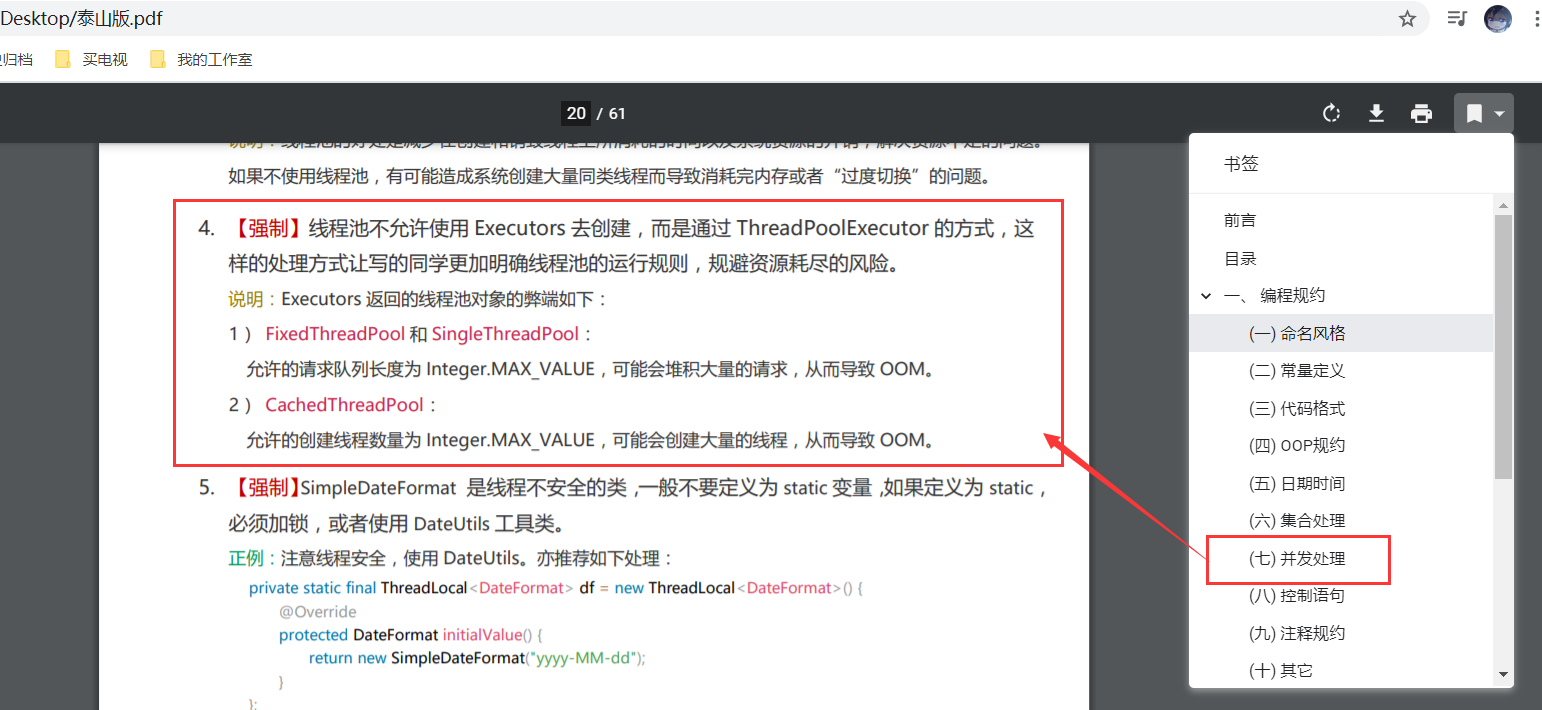
不允许使用 Executors 的三大方法,先了解它
package com.gfpz.pool;
import java.util.concurrent.ExecutorService;
import java.util.concurrent.Executors;
public class Demo01 {
public static void main(String[] args) {
// ExecutorService threadPool = Executors.newSingleThreadExecutor();//单个线程;不会拒绝请求,可能堆积大量请求,导致OOM
// ExecutorService threadPool = Executors.newFixedThreadPool(5);//固定数目的线程数;不会拒绝,可能堆积大量请求,导致OOM
ExecutorService threadPool = Executors.newCachedThreadPool();//可伸缩的,遇强则强;允许创建大量的线程,可能导致OOM
try {
for (int i = 0; i < 100; i++) {
//使用线程池创建线程
threadPool.execute(() -> {
System.out.println(Thread.currentThread().getName() + " 0k");
});
}
} catch (Exception e) {
e.printStackTrace();
} finally {
//线程池用完,程序结束,关闭线程池
threadPool.shutdown();
}
}
}
七大参数
三大方法本质都是用的 ThreadPoolExecutor 创建的
public static ExecutorService newSingleThreadExecutor() {
return new FinalizableDelegatedExecutorService
(new ThreadPoolExecutor(1, 1,
0L, TimeUnit.MILLISECONDS,
new LinkedBlockingQueue<Runnable>()));
}
public static ExecutorService newFixedThreadPool(int nThreads) {
return new ThreadPoolExecutor(nThreads, nThreads,
0L, TimeUnit.MILLISECONDS,
new LinkedBlockingQueue<Runnable>());
}
public static ExecutorService newCachedThreadPool() {
return new ThreadPoolExecutor(0, Integer.MAX_VALUE,
60L, TimeUnit.SECONDS,
new SynchronousQueue<Runnable>());
}
ThreadPoolExecutor 有7个构造参数(阿里要求同学自己创建线程池,用这个构造方法)
public ThreadPoolExecutor(int corePoolSize,//核心线程池大小
int maximumPoolSize,//最大线程池大小
long keepAliveTime,//超时了没人调用就释放
TimeUnit unit,//超时单位
BlockingQueue<Runnable> workQueue,//阻塞队列
ThreadFactory threadFactory,//线程队列
RejectedExecutionHandler handler//拒绝策略
) {
if (corePoolSize < 0 ||
maximumPoolSize <= 0 ||
maximumPoolSize < corePoolSize ||
keepAliveTime < 0)
throw new IllegalArgumentException();
if (workQueue == null || threadFactory == null || handler == null)
throw new NullPointerException();
this.corePoolSize = corePoolSize;
this.maximumPoolSize = maximumPoolSize;
this.workQueue = workQueue;
this.keepAliveTime = unit.toNanos(keepAliveTime);
this.threadFactory = threadFactory;
this.handler = handler;
}
四种拒绝策略

package com.gfpz.pool;
import java.util.concurrent.*;
public class Demo01 {
public static void main(String[] args) {
//自定义线程池
int heShu = Runtime.getRuntime().availableProcessors();//优化
ExecutorService threadPool = new ThreadPoolExecutor(2//银行柜台平时开两个窗口
, heShu//,5最多开5个窗口
, 3//等3
, TimeUnit.SECONDS//秒钟
, new LinkedBlockingQueue<>(3)//3把等待办理业务的椅子
, Executors.defaultThreadFactory()//线程工厂
//4种拒绝策略(银行满了,还有人进来)
//,new ThreadPoolExecutor.AbortPolicy()//抛出异常:java.util.concurrent.RejectedExecutionException
//,new ThreadPoolExecutor.CallerRunsPolicy()//哪来的去哪里,main线程调用的,main线程自行处理业务
//,new ThreadPoolExecutor.DiscardPolicy()//不抛出异常,丢掉任务
,new ThreadPoolExecutor.DiscardOldestPolicy()//队列满了,尝试去和最早的竞争,不抛出异常
);
try {
for (int i = 1; i <= 9; i++) {
//使用线程池创建线程
threadPool.execute(() -> {
System.out.println(Thread.currentThread().getName() + " 0k");
});
}
} catch (Exception e) {
e.printStackTrace();
} finally {
//线程池用完,程序结束,关闭线程池
threadPool.shutdown();
}
}
}
所以:告诉面试官,用 ThreadPoolExecutor 创建线程池就完事了!
上文中设置最大线程数的地方有两种设置套路(涉及到调优):
- CPU密集型:设置为CPU核数
- IO密集型:判断程序中十分耗资源的IO线程(任务)数m,将最大线程数设置为>2m
四大函数式接口
函数式接口,就是四个必会的新东西之一,四个新东西:lambda表达式、链式编程、函数式接口、Stream流式计算
函数式接口:只有一个方法的接口;简化编程模型,在新版本的框架底层大量应用
诸如:
@FunctionalInterface
public interface Runnable {
public abstract void run();
}
List list = new ArrayList<>();
list.forEach(消费者类型的函数式接口);
四个接口(所谓接口,就是约定了一类事情的行业规则,比如三星抢占6G规则,就是定义一堆接口)

函数型接口Function
一个输入参数,一个输出类型(函数就意味着输入输出嘛)

测试
package com.gfpz.function;
import java.util.function.Function;
/**
* Function 函数型接口,有一个输入参数,有一个输出
* 只要是 函数型接口,就可以用 lambda 表达式简化
*/
public class Demo01 {
public static void main(String[] args) {
//工具类:传入啥,输出啥
/*Function function = new Function<String, String>() {//创建匿名内部类
@Override
public String apply(String str) {
return str;
}
};*/
// Function<String, String> function = (str)->{return str;};
Function<String, String> function = str->{return str;};
System.out.println(function.apply("test"));
}
}
断定型接口Predicate
一个输入参数,一个输出类型(固定为布尔类型)(把输入给老先生,测凶吉)

测试
package com.gfpz.function;
import java.util.function.Predicate;
/**
* 断定型接口
*/
public class Demo02 {
public static void main(String[] args) {
//判断字符串是否为空
/*Predicate<String> predicate = new Predicate<String>() {
@Override
public boolean test(String str) {
return str.isEmpty();
}
};*/
Predicate<String> predicate = str->{return str.isEmpty();};
System.out.println(predicate.test(""));
}
}
消费型接口Consumer
只有输入,没有返回值
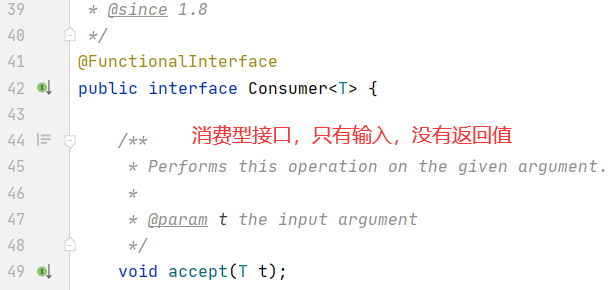
测试
package com.gfpz.function;
import java.util.function.Consumer;
/**
* 消费型接口,只有输入没有输出
*/
public class Demo03 {
public static void main(String[] args) {
/*Consumer<String> consumer = new Consumer<String>() {
@Override
public void accept(String s) {
System.out.println(s);
}
};*/
Consumer<String> consumer = s -> {
System.out.println(s);
};
consumer.accept("sad");
}
}
供给型接口Supplier
没有输入参数,只有返回值
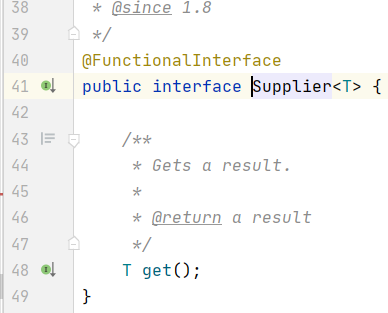
测试
package com.gfpz.function;
import java.util.function.Supplier;
/**
* 供给型接口,没有参数只有返回值
*/
public class Demo04 {
public static void main(String[] args) {
/*Supplier<Integer> supplier = new Supplier<Integer>() {
@Override
public Integer get() {
return 1024;
}
};*/
Supplier<Integer> supplier = () -> {return 1024;};
System.out.println(supplier.get());
}
}
Stream流式计算
大数据:存储+计算;集合、MySQL本质是存储数据;计算,交给流来搞。
package com.gfpz.stream;
import lombok.AllArgsConstructor;
import lombok.Data;
import lombok.NoArgsConstructor;
import java.util.Arrays;
import java.util.List;
/**
* 要求:一分钟内完成,一行代码实现筛选
* 1、id为偶数
* 2、年龄大于23
* 3、用户名转为大写字母
* 4、用户名倒着排序
* 5、只输出一个用户名
*/
public class Test {
public static void main(String[] args) {
User u1 = new User(1, "a", 21);
User u2 = new User(2, "b", 22);
User u3 = new User(3, "c", 23);
User u4 = new User(4, "d", 24);
User u5 = new User(6, "e", 25);
List<User> list = Arrays.asList(u1, u2, u3, u4, u5);
list.stream()
.filter(u->{return u.getId()%2==0;})
.filter(u->{return u.getAge() > 23;})
.map(u->{return u.getName().toUpperCase();})
.sorted((uu1,uu2)->{return uu2.compareTo(uu1);})
.limit(1)
.forEach(System.out::println);
}
}
@Data//get set toString
@NoArgsConstructor
@AllArgsConstructor
class User {
private int id;
private String name;
private int age;
}
ForkJoin分支合并
分治法 + 工作窃取:大数据量下使用

用例:10亿以内的自然数求和
package com.gfpz.forkjoin;
import java.util.concurrent.ExecutionException;
import java.util.concurrent.ForkJoinPool;
import java.util.concurrent.ForkJoinTask;
import java.util.concurrent.RecursiveTask;
import java.util.stream.LongStream;
/**
* 求和计算
*/
public class ForkJoinDemo extends RecursiveTask<Long> {
private Long start;
private Long end;
//临界值
private Long temp = 10000L;
public ForkJoinDemo(Long start, Long end) {
this.start = start;
this.end = end;
}
//计算方法
@Override
protected Long compute() {
if ((end - start) < temp) {
long sum = 0L;
for (long i = start; i <= end; i++) {
sum += i;
}
return sum;
}else{//像递归
long middle = (start + end) / 2;//中间值
ForkJoinDemo task1 = new ForkJoinDemo(start, middle);
task1.fork();//拆分任务,把任务压入线程队列
ForkJoinDemo task2 = new ForkJoinDemo(middle+1, end);
task2.fork();
return task1.join() + task2.join();//合并
}
}
public static void main(String[] args) throws ExecutionException, InterruptedException {
// test1();//365
// test2();//818
test3();//706
}
//月薪3k
public static void test1() {
long sum = 0L;
long startTime = System.currentTimeMillis();
for (long i = 1L; i <= 10_0000_0000; i++) {
sum += i;
}
long endTime = System.currentTimeMillis();
System.out.println("sum="+sum+",时间:"+(endTime-startTime));
}
//月薪6k:ForkJoin
public static void test2() throws ExecutionException, InterruptedException {
long startTime = System.currentTimeMillis();
ForkJoinPool forkJoinPool = new ForkJoinPool();
ForkJoinTask<Long> task = new ForkJoinDemo(0L, 10_0000_0000L);
ForkJoinTask<Long> submit = forkJoinPool.submit(task);//直观上看就是起多线程来完成一堆任务
Long sum = submit.get();
long endTime = System.currentTimeMillis();
System.out.println("sum="+sum+",时间:"+(endTime-startTime));
}
//月薪9k:Stream并行流
public static void test3() {
long startTime = System.currentTimeMillis();
long sum = LongStream.rangeClosed(0L, 10_0000_0000L).parallel().reduce(0, Long::sum);
long endTime = System.currentTimeMillis();
System.out.println("sum="+sum+",时间:"+(endTime-startTime));
}
}
异步回调
Future 设计初衷:对将来的某个事件的结果进行建模

package com.gfpz.future;
import java.util.concurrent.CompletableFuture;
import java.util.concurrent.ExecutionException;
import java.util.concurrent.TimeUnit;
/**
* 异步调用
*/
public class Demo01 {
public static void main(String[] args) throws ExecutionException, InterruptedException {
// test1();
test2();
}
//没有返回值的 异步回调
public static void test1() throws ExecutionException, InterruptedException {
CompletableFuture<Void> completableFuture = CompletableFuture.runAsync(()->{
try {
TimeUnit.SECONDS.sleep(2);
} catch (InterruptedException e) {
e.printStackTrace();
}
System.out.println(Thread.currentThread().getName()+" runAsync=>Void");
});
System.out.println("sad");
completableFuture.get();//阻塞获取执行结果
}
//有返回值的异步回调
public static void test2() throws ExecutionException, InterruptedException {
CompletableFuture<Integer> integerCompletableFuture = CompletableFuture.supplyAsync(() -> {
System.out.println(Thread.currentThread().getName()+" supplyAsync=>Integer");
int a = 1/0;
return 1024;
});
int b = integerCompletableFuture.whenComplete((t, u) -> {
System.out.println("t=>" + t);//正常的返回结果
System.out.println("u=>" + u);//错误信息
}).exceptionally((e) -> {
System.out.println(e.getMessage());
return 2333;//类似404
}).get();
System.out.println(b);
}
}
JMM(Java内存模型)
请谈谈你对 volatile 的理解
- Java关键字
- Java虚拟机提供的轻量级的同步机制
- 保证可见性
- 不保证原子性
- 禁止指令重排
说到可见性,就要先从JMM说起:
因为在不同的硬件生产商和不同的操作系统下,内存的访问逻辑有一定的差异,结果就是当你的代码在某个系统环境下运行良好,并且线程安全,但是换了个系统就出现各种问题。Java内存模型,就是为了屏蔽系统和硬件的差异,让一套代码在不同平台下能到达相同的访问结果。
内存划分
JMM规定了内存主要划分为主内存和工作内存两种。此处的主内存和工作内存跟JVM内存划分(堆、栈、方法区)是在不同的层次上进行的,如果非要对应起来,主内存对应的是Java堆中的对象实例部分,工作内存对应的是栈中的部分区域,从更底层的来说,主内存对应的是硬件的物理内存,工作内存对应的是寄存器和高速缓存。
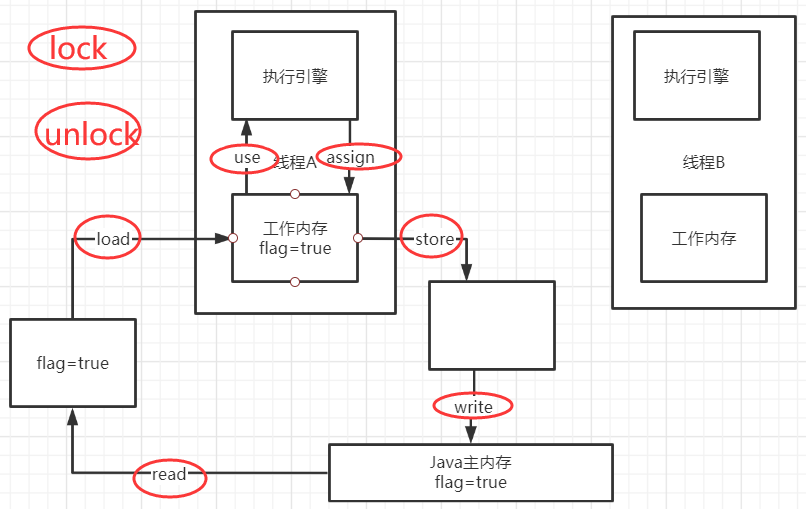
JVM在设计时候考虑到,如果JAVA线程每次读取和写入变量都直接操作主内存,对性能影响比较大,所以每条线程拥有各自的工作内存,工作内存中的变量是主内存中的一份拷贝,线程对变量的读取和写入,直接在工作内存中操作,而不能直接去操作主内存中的变量。但是这样就会出现一个问题,当一个线程修改了自己工作内存中变量,对其他线程是不可见的,会导致线程不安全的问题。因为JMM制定了一套标准来保证开发者在编写多线程程序的时候,能够控制什么时候内存会被同步给其他线程。
内存交互操作
内存交互操作有8种,虚拟机实现必须保证每一个操作都是原子的,不可在分的(对于double和long类型的变量来说,load、store、read和write操作在某些平台上允许例外)
- lock (锁定):作用于主内存的变量,把一个变量标识为线程独占状态
- unlock(解锁):作用于主内存的变量,它把一个处于锁定状态的变量释放出来,释放后的变量才可以被其他线程锁定
- read (读取):作用于主内存变量,它把一个变量的值从主内存传输到线程的工作内存中,以便随后的load动作使用
- load (载入):作用于工作内存的变量,它把read操作从主存中变量放入工作内存中
- use (使用):作用于工作内存中的变量,它把工作内存中的变量传输给执行引擎,每当虚拟机遇到一个需要使用到变量的值,就会使用到这个指令
- assign(赋值):作用于工作内存中的变量,它把一个从执行引擎中接受到的值放入工作内存的变量副本中
- store (存储):作用于主内存中的变量,它把一个从工作内存中一个变量的值传送到主内存中,以便后续的write使用
- write (写入):作用于主内存中的变量,它把store操作从工作内存中得到的变量的值放入主内存的变量中
JMM对这八种指令的使用,制定了如下规则:
- 不允许read和load、store和write操作之一单独出现。即使用了read必须load,使用了store必须write
- 不允许线程丢弃他最近的assign操作,即工作变量的数据改变了之后,必须告知主存
- 不允许一个线程将没有assign的数据从工作内存同步回主内存
- 一个新的变量必须在主内存中诞生,不允许工作内存直接使用一个未被初始化的变量。就是怼变量实施use、store操作之前,必须经过assign和load操作
- 一个变量同一时间只有一个线程能对其进行lock。多次lock后,必须执行相同次数的unlock才能解锁
- 如果对一个变量进行lock操作,会清空所有工作内存中此变量的值,在执行引擎使用这个变量前,必须重新load或assign操作初始化变量的值
- 如果一个变量没有被lock,就不能对其进行unlock操作。也不能unlock一个被其他线程锁住的变量
- 对一个变量进行unlock操作之前,必须把此变量同步回主内存
按照上图的逻辑,就可能出现:程序不知道主内存的值已经被修改过了,因此引出了volatile
volatile
1、volatile保证可见性
package com.gfpz.tvolatile;
import java.util.concurrent.TimeUnit;
public class JMMDemo {
//不加 volatile 的话,线程1的死循环结束不了
//加了 volatile 可以保证可见性
private volatile static int num = 0;
public static void main(String[] args) {//main线程
new Thread(() -> {//线程1对主内存种num已经变化了毫不知情,所以一直不停下来
while (num == 0) {
}
}).start();
try {
TimeUnit.SECONDS.sleep(1);
} catch (InterruptedException e) {
e.printStackTrace();
}
num = 1;
System.out.println(num);
}
}
2、volatile不保证原子性
线程1在执行任务的时候,不能被打扰,也不能被分割
package com.gfpz.tvolatile;
/**
* 不保证原子性
*/
public class VDemo02 {
private volatile static int num = 0;//volatile 不保证原子性
public static void add(){//synchronized 可以保证
num++;
}
public static void main(String[] args) {
for (int i = 1; i <= 20; i++) {
new Thread(()->{
for (int j = 0; j < 1000; j++) {
add();
}
}).start();
}
while (Thread.activeCount() > 2) {//main gc
Thread.yield();//线程礼让
}
System.out.println(Thread.currentThread().getName()+" "+num);
}
}
反编译查看字节码文件 D:\cangku\juc\target\classes\com\gfpz\tvolatile>javap -c VDemo02.class
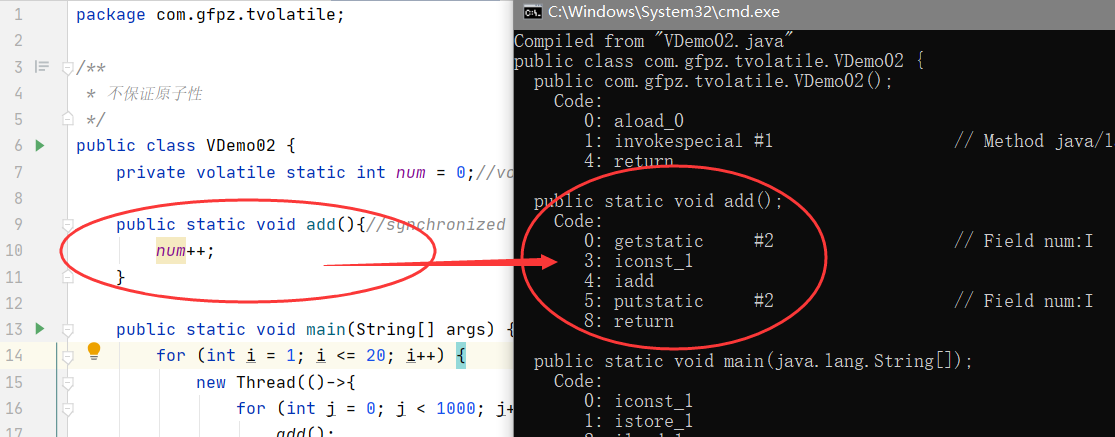
num++ 并非一个单纯的原子性操作
除了使用同步锁解决上面的原子性问题外,还可以使用原子类(比较高效,这些类的底层和操作系统挂钩)

package com.gfpz.tvolatile;
import java.util.concurrent.atomic.AtomicInteger;
/**
* AtomicInteger证原子性
*/
public class VDemo03 {
private static AtomicInteger num = new AtomicInteger();
public static void add(){
num.getAndIncrement();//底层用的Unsafe类 CAS
}
public static void main(String[] args) {
for (int i = 1; i <= 20; i++) {
new Thread(()->{
for (int j = 0; j < 1000; j++) {
add();
}
}).start();
}
while (Thread.activeCount() > 2) {//main gc
Thread.yield();//线程礼让
}
System.out.println(Thread.currentThread().getName()+" "+num);
}
}
3、禁止指令重排
我们所写的程序,计算机并不是按照我们看到的那样执行的,而是进行了重排,类似编译器按照文法优化重排、内存系统重排
利用内存屏障:
- 保证特定操作的执行顺序
- 保证某些变量的内存可见性
volatile在单例模式中有典型应用
彻底玩转单例模式
饿汉模式(浪费资源)
package com.gfpz.single;
//饿汉式单例
public class Hungry {
//会浪费空间,所以应该是需要用得时候才创建Hungry对象 即用懒汉模式
private byte[] data1 = new byte[1024*1024];
private byte[] data2 = new byte[1024*1024];
private byte[] data3 = new byte[1024*1024];
private byte[] data4 = new byte[1024*1024];
private Hungry() {
}
private final static Hungry HUNGRY = new Hungry();
public static Hungry getInstance() {
return HUNGRY;
}
}
DCL懒汉式(双重检测锁+volatile禁止指令重排)(也可能被反射破坏)
package com.gfpz.single;
import java.lang.reflect.Constructor;
import java.lang.reflect.Field;
//懒汉式单例
public class LazyMan {
/*public LazyMan() {
System.out.println(Thread.currentThread().getName()+" ok");
}*/
private static boolean xiaoming = false;
public LazyMan() {
synchronized (LazyMan.class) {
/*
if (lazyMan != null) {//第三重检测
throw new RuntimeException("不要试图使用反射破坏单例");
}
*/
if (!xiaoming){
xiaoming = true;
}else{
throw new RuntimeException("不要试图使用反射破坏单例");
}
}
}
/*
private static LazyMan lazyMan;
//单线程下单例ok 多线程下有问题
public static LazyMan getInstance() {
if(null ==lazyMan){
lazyMan = new LazyMan();
}
return lazyMan;
}*/
private volatile static LazyMan lazyMan;//volatile
//双重检测锁模式+volatile禁止指令重排 DCL懒汉!!!!!!!!!!!!!!!!
public static LazyMan getInstance() {
if(null ==lazyMan){
synchronized (LazyMan.class) {
if(null ==lazyMan){
lazyMan = new LazyMan();//不是原子性操作,极端情况下也是有问题得
/**
* 1分配内存空间
* 2执行构造方法,初始化对象
* 3把对象指向这个空间
* 可能因指令重排产生问题
*/
}
}
}
return lazyMan;
}
public static void main(String[] args) throws Exception {
/*
//测试
for (int i = 0; i < 10; i++) {
new Thread(()->{
LazyMan.getInstance();
}).start();
}*/
//反射破坏单例模式
//LazyMan instance = LazyMan.getInstance();
Field xiaoming = LazyMan.class.getDeclaredField("xiaoming");
xiaoming.setAccessible(true);
Constructor<LazyMan> declaredConstructor = LazyMan.class.getDeclaredConstructor(null);
declaredConstructor.setAccessible(true);
LazyMan instance = declaredConstructor.newInstance();
xiaoming.set(instance,false);
LazyMan instance2 = declaredConstructor.newInstance();
System.out.println(instance.hashCode());
System.out.println(instance2.hashCode());
}
}
静态内部类玩法
package com.gfpz.single;
//静态内部类
public class Holder {
private Holder() {
}
public static Holder getInstance() {
return InnerClass.HOLDER;
}
public static class InnerClass{
private static final Holder HOLDER = new Holder();
}
}
枚举避免破坏单例模式
package com.gfpz.single;
import java.lang.reflect.Constructor;
//enum 本身也是一个class类
public enum EnumSingle {
INSTANCE;
public EnumSingle getInstance() {
return INSTANCE;
}
}
class Test{
//Cannot reflectively create enum objects 结论:枚举可以防止反射破坏单例
public static void main(String[] args) throws Exception {
// EnumSingle instance1 = EnumSingle.INSTANCE;
// EnumSingle instance2 = EnumSingle.INSTANCE;
// System.out.println(instance1);
// System.out.println(instance2);
EnumSingle instance1 = EnumSingle.INSTANCE;
//Constructor<EnumSingle> declaredConstructor = EnumSingle.class.getDeclaredConstructor(null);
Constructor<EnumSingle> declaredConstructor = EnumSingle.class.getDeclaredConstructor(String.class, int.class);
declaredConstructor.setAccessible(true);
EnumSingle instance2 = declaredConstructor.newInstance();
//NoSuchMethodException
System.out.println(instance1);
System.out.println(instance2);
}
}
Java自带反编译工具查看所有类和成员

用 jad.exe 将字节码文件反编译为Java文件,查看发现真实参构造器 EnumSingle(String s, int i)

理解CAS比较并交换
比较 工作内存中 和 主内存中 的值,如果这是值是期望的,那么执行更新操作;如果不是,就一直循环(自旋锁)
package com.gfpz.cas;
import java.util.concurrent.atomic.AtomicInteger;
public class CASDemo {
public static void main(String[] args) {
AtomicInteger atomicInteger = new AtomicInteger(2020);//给它一个初始值
//CAS:compareAndSet 比较并交换
//public final boolean compareAndSet(int expect, int update)
//如果刚好是是期望值,就进行修改/更新
//CAS 是cpu的并发原语 此处是Java层面的套用
System.out.println(atomicInteger.compareAndSet(2020, 2021));
System.out.println(atomicInteger);
atomicInteger.incrementAndGet();
atomicInteger.getAndIncrement();
System.out.println(atomicInteger.compareAndSet(2020, 2021));
System.out.println(atomicInteger);
}
}
利用Unsafe类操作内存
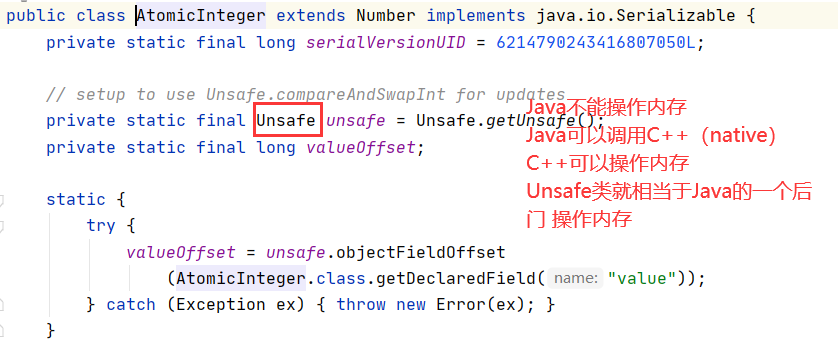
自旋锁
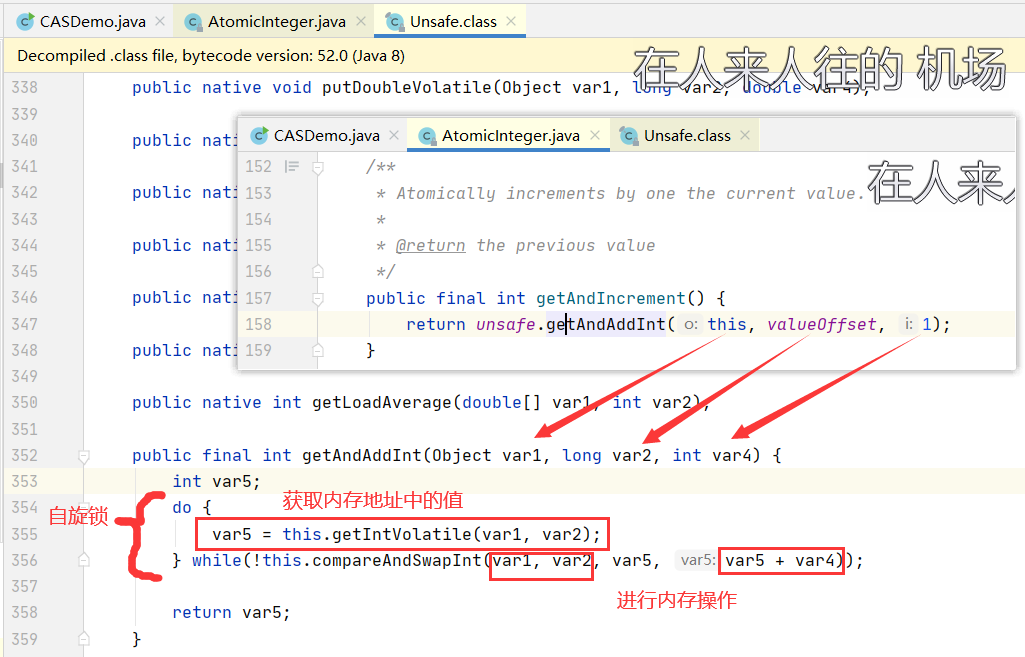
缺点:
- 循环会耗时
- 一次性只能保证一个共享变量的原子性
- ABA问题
ABA问题
操作的值是被人动手脚的值,意义变了
package com.gfpz.cas;
import java.util.concurrent.atomic.AtomicInteger;
public class CASDemo {
//乐观锁
public static void main(String[] args) {
AtomicInteger atomicInteger = new AtomicInteger(2020);//给它一个初始值
//捣乱的线程
System.out.println(atomicInteger.compareAndSet(2020, 2021));
System.out.println(atomicInteger);
System.out.println(atomicInteger.compareAndSet(2021, 2020));
System.out.println(atomicInteger);
//期望的线程
System.out.println(atomicInteger.compareAndSet(2020, 6666));
System.out.println(atomicInteger);
}
}
原子引用解决ABA问题
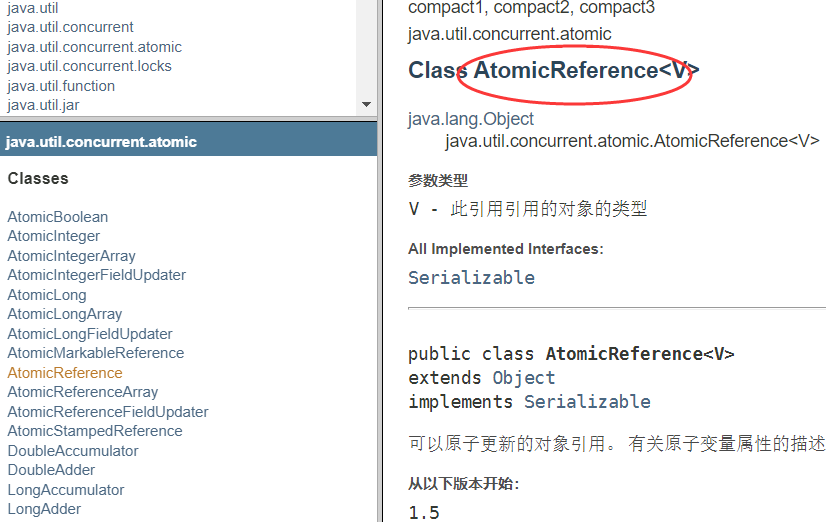
package com.gfpz.cas;
import java.util.concurrent.TimeUnit;
import java.util.concurrent.atomic.AtomicInteger;
import java.util.concurrent.atomic.AtomicReference;
import java.util.concurrent.atomic.AtomicStampedReference;
public class CASDemo {
//跟乐观锁的原理相同
public static void main(String[] args) {
// AtomicInteger atomicInteger = new AtomicInteger(2020);//给它一个初始值
//如果泛型是包装类,注意对象的引用问题 正常不会比较Integer
AtomicStampedReference<Integer> atomicStampedReference = new AtomicStampedReference<>(1,1);
new Thread(()->{
int stamp = atomicStampedReference.getStamp();//获得版本号
System.out.println("a1=>"+stamp);
try {
TimeUnit.SECONDS.sleep(2);
} catch (InterruptedException e) {
e.printStackTrace();
}
System.out.println("a "+atomicStampedReference.compareAndSet(1, 2
, atomicStampedReference.getStamp(), atomicStampedReference.getStamp() + 1));
System.out.println("a2=>"+atomicStampedReference.getStamp());
System.out.println("a "+atomicStampedReference.compareAndSet(2, 1
, atomicStampedReference.getStamp(), atomicStampedReference.getStamp() + 1));
System.out.println("a3=>"+atomicStampedReference.getStamp());
},"a").start();
new Thread(()->{
int stamp = atomicStampedReference.getStamp();
System.out.println("b1=>"+stamp);
try {
TimeUnit.SECONDS.sleep(2);
} catch (InterruptedException e) {
e.printStackTrace();
}
System.out.println("b "+atomicStampedReference.compareAndSet(2, 6, stamp, stamp + 1));
System.out.println("b2=>"+atomicStampedReference.getStamp());
},"b").start();
}
}
Integer使用了对象缓存机制,默认范围是-128~127,推荐使用静态工厂方法valueOf获取对象实例,而不是new,因为valueOf使用缓存,而new一定会创建新的对象分配新的内存空间

各种锁的概念
公平锁
非常公平,不能够插队,必须先来后到
非公平锁
不公平,可以插队,3s不用等3h,默认都是非公平锁
//创建锁的时候设置公平锁和非公平锁
public ReentrantLock() {
sync = new NonfairSync();
}
public ReentrantLock(boolean fair) {
sync = fair ? new FairSync() : new NonfairSync();
}
可重入锁(递归锁)
拿到了外面的锁之后,就可以拿到里边的锁,自动获得
synchronized 版
package com.gfpz.lock;
//synchronized
public class Demo01 {
public static void main(String[] args) {
Phone phone = new Phone();
new Thread(() -> {
phone.sms();
},"A").start();
new Thread(() -> {
phone.sms();
},"B").start();
}
}
class Phone{
public synchronized void sms() {
System.out.println(Thread.currentThread().getName()+" sms");
call();//这里也有锁
}
public synchronized void call() {
System.out.println(Thread.currentThread().getName()+" call");
}
}
Lock 版
package com.gfpz.lock;
import java.util.concurrent.locks.Lock;
import java.util.concurrent.locks.ReentrantLock;
//synchronized
public class Demo02 {
public static void main(String[] args) {
Phone2 phone = new Phone2();
new Thread(() -> {
phone.sms();
},"A").start();
new Thread(() -> {
phone.sms();
},"B").start();
}
}
class Phone2 {
Lock lock = new ReentrantLock();
public void sms() {
lock.lock();
lock.lock();
try {
System.out.println(Thread.currentThread().getName() + " sms");
call();
} catch (Exception e) {
e.printStackTrace();
}finally {
lock.unlock();
lock.unlock();
}
}
public void call() {
lock.lock();
try {
System.out.println(Thread.currentThread().getName() + " call");
} catch (Exception e) {
e.printStackTrace();
}finally {
lock.unlock();
}
}
}
自旋锁
自定义锁
package com.gfpz.lock;
import java.util.concurrent.TimeUnit;
import java.util.concurrent.atomic.AtomicReference;
public class SpinlockDemo {
AtomicReference<Thread> atomicReference = new AtomicReference<>();
//加锁
public void myLock() {
Thread thread = Thread.currentThread();
System.out.println(Thread.currentThread().getName() + "==>mylock");
//自旋锁
while (!atomicReference.compareAndSet(null, thread)) {
}
}
//解锁
public void myUnLock() {
Thread thread = Thread.currentThread();
System.out.println(Thread.currentThread().getName() + "==>myUnLock");
atomicReference.compareAndSet(thread, null);
}
}
class TestSpinlock {
public static void main(String[] args) throws Exception {
SpinlockDemo lock = new SpinlockDemo();
new Thread(() -> {
lock.myLock();
try {
TimeUnit.SECONDS.sleep(5);
} catch (Exception e) {
e.printStackTrace();
} finally {
lock.myUnLock();
}
}, "T1").start();
TimeUnit.SECONDS.sleep(1);
new Thread(() -> {
lock.myLock();
try {
TimeUnit.SECONDS.sleep(1);
} catch (Exception e) {
e.printStackTrace();
} finally {
lock.myUnLock();
}
}, "T2").start();
}
}
死锁
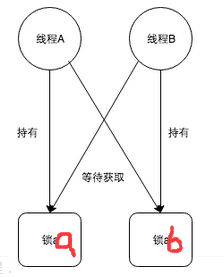
package com.gfpz.lock;
import java.util.concurrent.TimeUnit;
public class DeadLockDemo {
public static void main(String[] args) {
String lockA = "lockA";
String lockB = "lockB";
new Thread(new MyThread(lockA,lockB),"T1").start();
new Thread(new MyThread(lockB,lockA),"T2").start();
}
}
class MyThread implements Runnable {
private String lockA;
private String lockB;
public MyThread(String lockA, String lockB) {
this.lockA = lockA;
this.lockB = lockB;
}
@Override
public void run() {
synchronized (lockA) {
System.out.println(Thread.currentThread().getName() + " lock:" + lockA + "==>get" + lockB);
try {
TimeUnit.SECONDS.sleep(2);
} catch (InterruptedException e) {
e.printStackTrace();
}
synchronized (lockB) {
System.out.println(Thread.currentThread().getName() + " lock:" + lockB + "==>get" + lockA);
}
}
}
}
解决死锁
1、线上异常
2、日志
3、查看堆栈信息
使用 jps -l 定位进程号
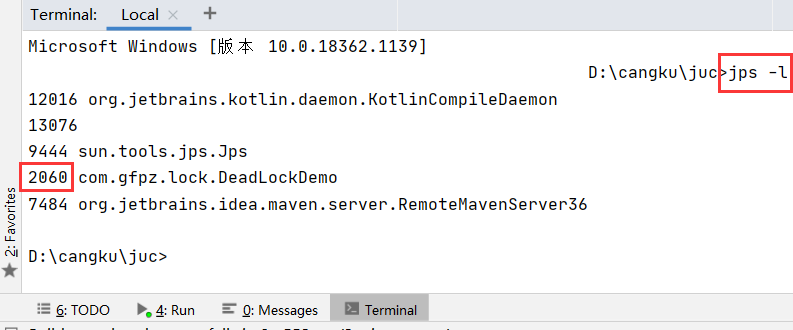
使用 jstack 进程号 查看
